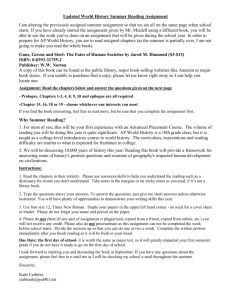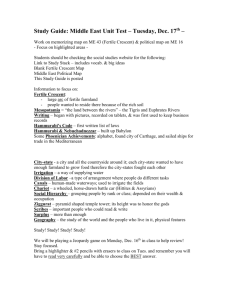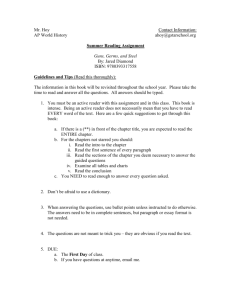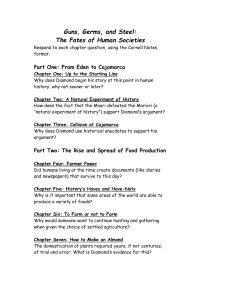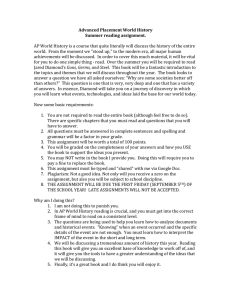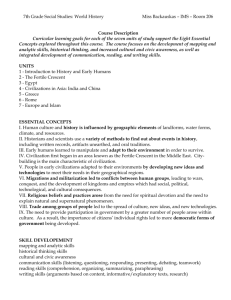AP World History Summer Reading Assignment Guns, Germs, and
advertisement
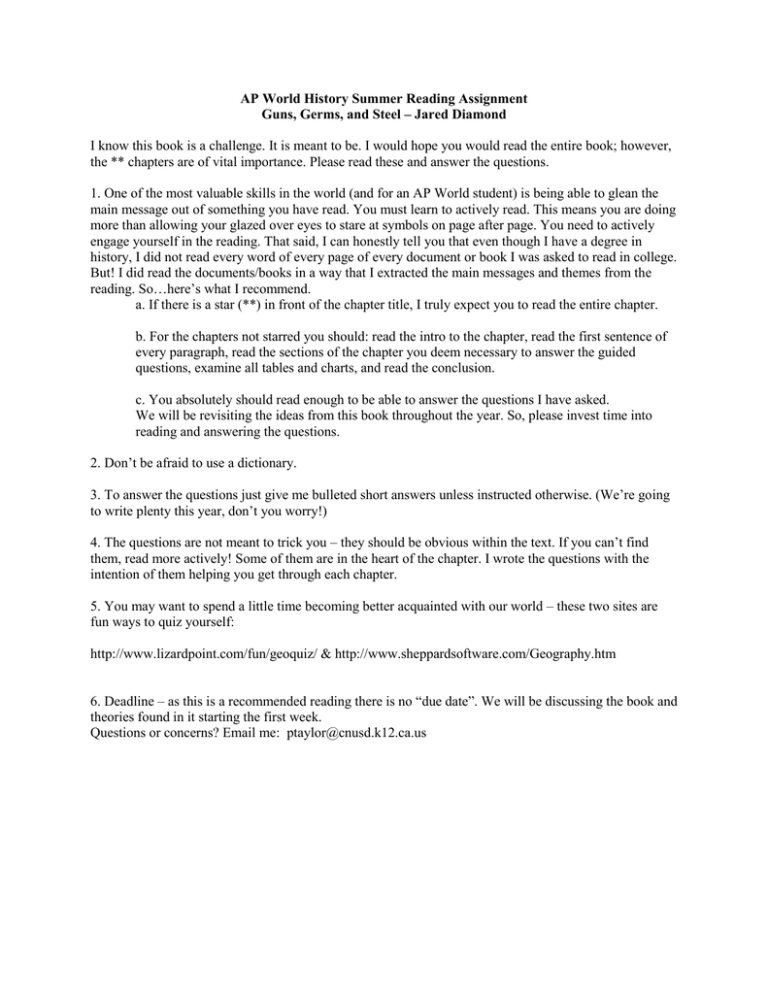
AP World History Summer Reading Assignment Guns, Germs, and Steel – Jared Diamond I know this book is a challenge. It is meant to be. I would hope you would read the entire book; however, the ** chapters are of vital importance. Please read these and answer the questions. 1. One of the most valuable skills in the world (and for an AP World student) is being able to glean the main message out of something you have read. You must learn to actively read. This means you are doing more than allowing your glazed over eyes to stare at symbols on page after page. You need to actively engage yourself in the reading. That said, I can honestly tell you that even though I have a degree in history, I did not read every word of every page of every document or book I was asked to read in college. But! I did read the documents/books in a way that I extracted the main messages and themes from the reading. So…here’s what I recommend. a. If there is a star (**) in front of the chapter title, I truly expect you to read the entire chapter. b. For the chapters not starred you should: read the intro to the chapter, read the first sentence of every paragraph, read the sections of the chapter you deem necessary to answer the guided questions, examine all tables and charts, and read the conclusion. c. You absolutely should read enough to be able to answer the questions I have asked. We will be revisiting the ideas from this book throughout the year. So, please invest time into reading and answering the questions. 2. Don’t be afraid to use a dictionary. 3. To answer the questions just give me bulleted short answers unless instructed otherwise. (We’re going to write plenty this year, don’t you worry!) 4. The questions are not meant to trick you – they should be obvious within the text. If you can’t find them, read more actively! Some of them are in the heart of the chapter. I wrote the questions with the intention of them helping you get through each chapter. 5. You may want to spend a little time becoming better acquainted with our world – these two sites are fun ways to quiz yourself: http://www.lizardpoint.com/fun/geoquiz/ & http://www.sheppardsoftware.com/Geography.htm 6. Deadline – as this is a recommended reading there is no “due date”. We will be discussing the book and theories found in it starting the first week. Questions or concerns? Email me: ptaylor@cnusd.k12.ca.us Guns, Germs, and Steel – Guide **Prologue: Yali’s Question 1. What is Yali’s Question? 2. What are three considerations Diamond discusses as he ponders Yali’s question? II. Part Two: The Rise and Spread of Food Production **Chapter Four: Farmer Power 1. According to Figure 4.1 what is a prerequisite to the development of technology? 2. In one paragraph or less please summarize how domestication of livestock and farming changed societies. **Chapter Five: History’s Haves and Have-nots 1. Examine Figure 5.1 and Table 5.1; apply your knowledge of environmental and geographic factors to identify what these regions have in common. What environmental factors probably contributed to the success of these crops in their respective regions? **Chapter 6: To Farm or Not to Farm 1. What five factors contributed to the transition from hunter gatherer to farming? **Chapter Seven: How to Make an Almond 1. Describe three of the many factors that contribute to whether or not a plant becomes a crop that humans choose to domesticate. **Chapter 8: Apples or Indians 1. Identify at least four of the Fertile Crescent’s advantages in terms of food production. 2. Identify New Guinea’s 3 severe limitations. 3. When comparing Eastern United States, New Guinea, and the Fertile Crescent, what caused such a great difference in production? 4. What happened when more productive crops arrived from elsewhere (p. 153) 5. What two conclusions does Diamond want to exaggerate? **Chapter 10: Spacious Skies and Tilted Axes 1. How did the rate of spread in Eurasia’s East-West axes compare to the spread along the Americas North-South axes? (p. 178) 2. In paragraph from, why was the spread of crops from the Fertile Crescent so rapid? 3. Why was the rate of diffusion in the Americas so slow? Part 3: From Food to Guns, Germs, and Steel **Chapter 11: Lethal Gift of Livestock 1. What are two historically famous epidemics? 2. What are the four common characteristics shared by lethal epidemics? 3. Why did the rise of agriculture launch the evolution of infectious diseases? (In complete sentences) (page 205) 4. List four diseases that are contracted from an animal. **Chapter 18: Hemispheres Colliding 1. Using pages 354-357, make a chart that compares and contrasts Eurasian and Native American society prior to 1492. 2. Describe the five areas of technology that were contributing factors to Europe’s conquest of the Americas. 3. Referencing Table 18.1; Which is the earliest developing society? Second earliest? Third? Which societies never developed writing systems? Which never developed iron tools? 4. What has the Native American population reduced by (%) since 1492? **Chapter 19: How Africa Became Black 1. List the five major human groups in Africa around 1000 CE (AD). 2. How many different language groups exist in the African continent? 3. Describe the characteristics and growth of the Bantus. 4. What does Diamond project actually happened to the vanished Khoisan populations? **Epilogue: The Future of Human History as a Science 1. Describe Diamonds explanation for why Europe rose to be a global leader instead of China or the Fertile Crescent. (In paragraph form)
